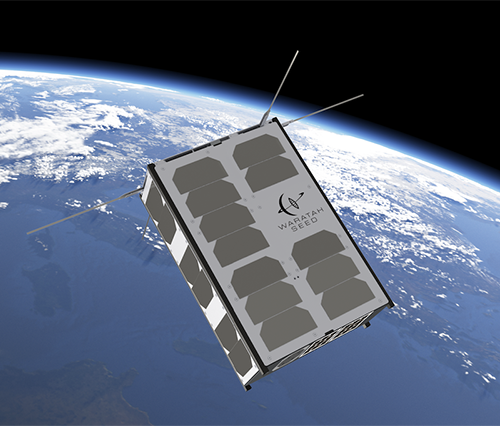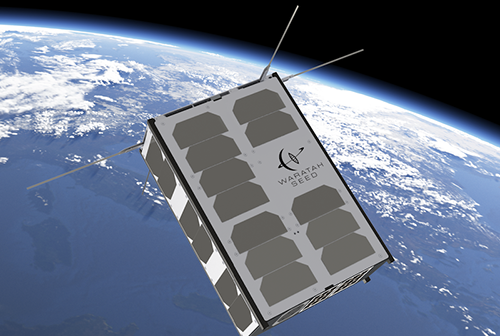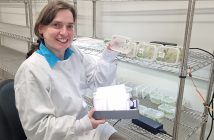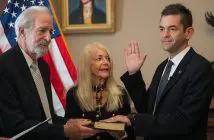
An Australian built and operated cube satellite has won the SmallSat Mission of the Year award at the ‘Space Oscars’ at a ceremony in Salt Lake City, Utah, USA.
Backed by voting Australians and supported by the judges, Waratah Seed was crowned winner in of a field of 10 missions, including finalists from NASA Goddard, the European Space Agency, Purdue University, NASA’s Jet Propulsion Laboratory and Johns Hopkins University.
Waratah Seed is a cube satellite (CubeSat) with a diverse scientific and commercial payload backed by the NSW Government, SmartSat CRC , space companies, and a consortium of universities led by the University of Sydney.
Waratah Seed was the only Australian finalist in the SmallSat Mission of the Year hosted by the American Institute of Aeronautics and Astronautics. Mission leader is Professor Iver Cairns from the University of Sydney School of Physics. He is also Director of CUAVA the ARC Training Centre for CubeSats, UAVs and their Applications.
Professor Cairns said: “We are all thrilled to have won this award. It is testament to the engineering and scientific ingenuity of our team at the University of Sydney, UTS, Macquarie University and our industry partners at Saber Astronautics, Delta-V and the Australian Centre for Space Engineering Research at UNSW.
“We thought our little Aussie satellite, packed with an unlikely nine scientific and commercial payloads, would last in space for six months. But now, just three days shy of a year in space, it is still orbiting Earth nearly 500 kilometres above ground and sending back data at the cool speed of 27,000 kilometres an hour.
“It will next pass over Sydney tonight at 10.26pm, so we will give it a little wave. “It shows Australia has a great future in the space industry. Thank you to the NSW Government for backing the mission.”
About the Waratah Seed-1 satellite:
Australia’s first ride-share satellite, Waratah Seed-1 launched into orbit on 17 August 2024 AEST at 4.35am. Funded by the NSW Government’s pilot ‘Space Qualification Mission’ grant, and sponsored by SmartSat CRC, Aurora and Raytheon Australia, the Waratah Seed-1 satellite was built by CUAVA, the ARC Training Centre for CubeSats, UAVs and their Applications, in the School of Physics at the University of Sydney.
Waratah Seed’s first mission carries five payloads from winners of a Payload Competition to support NSW-based space-technology start-ups to demonstrate their technology in space and to engage new export markets. Also onboard are four research technology payloads developed by academic and commercial space teams.
The Waratah Seed-1 satellite’s primary mission has been to engage NSW-based space technology startups to fly with the mission at reduced cost, enabling them to test and demonstrate the viability and space-readiness of their technology. This ‘space heritage’ is essential to gaining investment and export opportunities.
Other mission objectives were to assess interest in future ‘ride-share’ missions for Australian companies and research organisations for research purposes and as ‘demonstrators’ to test new space technology, to raise awareness of the NSW Space Ecosystem, and to support the development of space technology with the potential for manufacturing and export.
The Waratah Seed-1 Mission was officially designated ‘Mission : Accomplished’ at a celebratory event in April, 2025.
What’s on board?
The Waratah Seed-1 mission carries nine technology payloads:
PORT-2 – a Perovskites in Orbit Readiness Test designed by EurokaPower, Anita Ho-Baillie. These solar cells are self-healing, and designed to improve the cost, performance and durability of spacecraft solar cells
and could be manufactured in Australia.
Space Edge-2 – an innovative space edge computing system designed by Spiral Blue, designed to deliver in-orbit image processing and delivery of near real-time observation data onboard Earth observation satellites. An experimental meta-material developed by Dandelions using natural fibres such as
flax and hemp, designed to provide a cost-effective, heat-resistant alternative to carbon fibre for use in spacecraft insulation. Innovative solar cells based on terrestrial silicon technologies designed by
ExtraTerrestrial Power, which aim to make the cells more resistant to radiation and significantly increase their operating life in space.
Subsystems and sensors for a robot arm by SperoSpace using unique tactile grips developed by partners Contactile, designed to enable in-orbit satellite maintenance, assembly, manufacturing and debris removal.
Matilda – a new spacecraft thermal management system developed by Mawson Rovers and UTS, using a 3D printed heat sync payload with an integrated phase-change material which releases thermal energy over a period of time.
Harry3 – a GPS reflectometry payload developed by the Australian Centre for Space Engineering Research at UNSW, designed to monitor ocean conditions remotely by measuring signals scattered off the waves.
SPaDeS – a submillimetre particle detection system designed at the School of Physics at the University of Sydney, to detect space debris particle impacts on satellites, and measure the Earth’s ionospheric plasma.
E-Mag – an ElectroPermanent Magnetorquer designed and built by University of Sydney university start-up, Deneb Space, to measure and change the positioning of satellites using far less power than conventional control systems.





